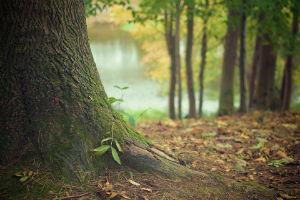Pollution hits the fungi that nourish European trees
07 June 2018

A huge study of 13,000 soil samples across 20 European countries has revealed that many tree fungi communities are stressed by pollution, indicating that current pollution limits may not be strict enough.
To get nutrients from the soil, trees host fungi, known as mycorrhizal fungi, in their roots. These fungi receive carbon from the tree in exchange for essential nutrients, like nitrogen, phosphorus and potassium, which they gather from the soil. Some of these fungi are known above-ground from the mushrooms and truffles they form.
This plant-fungal symbiotic relationship is crucial for the health of the tree. Recent studies have noted signs of tree malnutrition across Europe, such as discoloured leaves or leaves lost from the crown, but the mechanisms underpinning these symptoms are unclear.
Now, in a ten-year pan-European study involving Dr Hyun Soon Gweon, who is now based in the University of Reading's Department of Biological Sciences, researchers have revealed that tree characteristics and local air and soil quality have a large impact on mycorrhizae.
“This is just the first step to understanding the relationship between the trees and the hidden world of mycorrhizae on a global scale" - Dr Soon Gweon, University of Reading
Lead researcher Dr Martin Bidartondo, from the Department of Life Sciences at Imperial and Kew Gardens, said: “There is an alarming trend of tree malnutrition across Europe, which leaves forests vulnerable to pests, disease and climate change. To see if changes in mycorrhizae might be behind this trend, we opened the ‘black box’ of soil. Processes happening in soil and roots are often ignored, assumed or modelled, because studying them directly is difficult, but it is crucial for assessing tree functioning.
“A major finding of the study is that European pollution limits may be set far too high. In North America the limits are set much lower, and we now have good evidence they should be similar in Europe. For example, current European nitrogen limits may need to be cut by half. Our trees in Europe are not more tolerant than those in North America – their fungi are just suffering more.”
Damaging minerals
The study, published in Nature, was led by Imperial College London and the Royal Botanic Gardens, Kew. It examined 40,000 roots from 13,000 soil samples at 137 forest sites in 20 European countries. This allowed the authors to discover large-scale trends in mycorrhizal communities, including their tolerance to pollution.
Dr Gweon analysed the DNA data from the mycorrhizae to test the hypothesis.
The team found that the characteristics of the tree (species and nutrient status) and the local environmental conditions (atmospheric pollution and soil variables) were the most important predictors of which species of mycorrhizal fungi would be present and their abundances.
Minerals like nitrogen and phosphorus are essential for life, but in high enough concentrations can be damaging, acting as pollutants rather than nutrients. The new study discovered ‘thresholds’ of these elements – concentrations above which the community of mycorrhizae changes.
Some mycorrhizal fungi are outcompeted by those that are more tolerant of pollution, such as species that can take advantage of the excess nitrogen from air pollution.
These ecosystem changes can negatively affect tree health. For example, the team proposes that some community changes result in more ‘parasitic’ mycorrhizae: those that take carbon but give little back in the way of nutrients.
Dr Gweon said: “This is just the first step to understanding the relationship between the trees and the hidden world of mycorrhizae on a global scale, and how it fits into the bigger picture of the environmental changes induced by human activities.”
